Exploring the outer islands of Papua New Guinea – Man Bags and Crocodiles
1Saturday 1 August 2015
Leaving Nissan Island the day started badly with strong currents and messy seas in little wind – we dreaded to think what it could be like in strong winds. The sad truth is that many here lose their lives at sea travelling between islands in so called ‘banana boats’ – low-sitting fibreglass boats with forty horsepower engines – that sometimes get overturned in big seas or the engine fails and they drift, hoping to land on another island.
Fortunately for us the seas calmed down and with little else to do out went our fishing lines – we have our good old fishing rod and two hand reels, new for us this season, which these days beat the rod hands-down. Susie had been demanding some treasured yellowfin tuna and her wishes came true as we chased after birds that follow the tuna and ended up landing three. Sashimi was on the menu! This was to be followed by mahi-mahi and lobster stew in freshly made coconut milk.
Our next anchorage at Feni Island had a tight swinging circle; we have a rule that if we don’t feel comfortable we move so we put the sashimi on hold and continued on to little Lif island, the third island in the chain of five islands situated to the east of New Ireland. Most of the islands are steep-to and don’t have many places to anchor but Lif island has a little reef to the east and you can tuck in behind it, anchoring in 20m of water sheltered in moderate winds by the reef.
It’s always good manners to go to the nearby village and meet the chief to ask permission to stay, swim, fish etc. We set off in our little rubber dinghy but just couldn’t see a way in as the coast was lined with reef and the tide was low. We drove up and down and had nearly given up when a wooden outrigger rowed out to help us. There was a minute gap and using a small wave the two men pulled us in and we then walked the next 5 minutes over reef, pulling our dinghy along behind us.
As it happened the chief was sitting in the community house with the local men in their weekly meeting. The community house looked a little like a boat with a roof and was built entirely by hand with local materials including timber frames and sago palm leaves for the roof – not a single nail in sight. As for the weekly meeting – well it was like any other weekly meeting we have back at work in England – printed agenda, everybody had weekly status reports from which to read out updates, one man was taking minutes and actions, and the chief went through the risks and issues log. Or perhaps they sat around the edges of the house chewing betel-nut with some used drinking coconuts thrown onto the ground in the middle of the room, talking a little, laughing a little. We were offered some drinking coconuts and then did what we always do to break the ice and tell them where we are from and where we are going. Standard responses are “From England? Long, long away!” followed by nods all around the room. “Over two years you are sailing? Oooh, long time.” “Just two of you?” and raised eyebrows of amazement and more nods of approval. One question we always get is “You are scared of the sea?” followed by serious questioning looks around the room and we regale them with stories of big nasty seas to satisfy their curiosity.
One thing we have observed in Papua New Guinea is that men carry handbags – yes, it seems good old man bags originated in Papua New Guinea. And they vary in style and texture according to where you are from. On the outer islands they have limited supplies so typically these are woven from palm leaves. But each one will be different and the men walk around with them, either carrying them in their hands or over their shoulders, dipping into them from time to time. Being curious and utterly nosy we keep trying to see what’s inside them. It’s mainly betel-nut and a bit of food but we saw some papers in one – no doubt the chief’s weekly meeting agenda ready to roll a cigarette with. The chief’s son had made an enormous bag almost half his body length in height and told us he carries his baby in it when he goes to his garden. As for the ladies, they have more conventional flat handbags but the straps are put over the head. Carrying a bag on your arm is strictly male domain. And who said Papua New Guineans are big fierce scary people?
Again we ran a basic medical clinic and visited the local school. This time round the chief wasn’t quite as proactive and most didn’t know about the clinic merely stumbling upon it, though we still treated over thirty people. Then he failed to turn up for the school tour or tell the school we were coming but nonetheless the headmistress welcomed us and asked us to speak to the pupils. We asked about school times and back came the reply from the headmistress “Normally eight to four, but this week is the first week after holidays and so we finish at twelve as we just don’t have the mood yet”. There must be many a pupil out there who desires such a headmistress.
Time to move on and we sailed to the next little island, Lihir. Lihir has a gold mine owned by an Australian company (big and obvious if you look on google maps). Papua New Guinea is apparently full of gold and oil reserves sitting waiting to be explored, for good or bad. We had come here to formally check-in to Papua New Guinea and complete our paperwork. The place was somewhat surreal – just a 6 hour sail away people live in traditional thatched houses on remote islands and live on the fruit and vegetables they grow themselves, and yet here was a gold mine with a town, electricity, cars, and supermarkets.
The anchorage is exposed to the trade winds so not ideal; we grabbed a fishing boat buoy and went to fetch the officials. No easy task in bumpy waters but all four of the officials were dead keen on coming aboard as a yacht is still a bit of a novelty. We transported them in relays and some took pictures of themselves at the front of the boat. They were a really friendly bunch and we have promised them we’ll publish their picture. Downside it was a public holiday and while they were all dressed in uniforms none had stamps or paperwork with them. So we endured a lumpy night on the mooring buoy, agreeing to meet them at 8am the next day. That of course didn’t happen, our patience was a little tested and we finally left at midday.
We sailed to the other side of the island to get shelter in a beautiful protected bay called Lakakot where a friendly Australian Mark Bassasini bases himself with a brick factory and a now closed resort. We stayed two days doing jobs on Adina, a little exploring, a little talking to the locals and a little resting.
Moving on to our final island in the chain, Tabar, we had a great sail and even bagged four bonito tuna for the locals. The Tabar islands have a passage between them with a bay plumb in the middle. We approached with caution as the current can run strongly in the passage and you need to keep a steady course. Swinging into the bay much to our astonishment was another yacht! The first we had seen since leaving Vanuatu in April. On board were Christina and Sebastian who have been sailing on their yacht for an incredible sixteen years. They base themselves in Malaysia and nowadays sail from there to the Solomon Islands and back, spending time in Papua New Guinea bringing materials for the locals they have met over the years. For us they were a gold mine of information as we could confirm our routes were good and pick their brains on places to go.
A real highlight here was that there was a crocodile in the bay and he could be seen basking away in the mangrove swamps. This was Susie’s first crocodile in the wild and of course drew excitement. Early one morning we spotted him swimming past the boat looking like a wooden log moving at some speed. Sebastian informed us it was a grey crocodile and they were ok. We still didn’t fancy a swim.
The passage in between the islands is well used by banana boats carrying people from side to side and of course two yachts is an attraction – many would just stop and come up to investigate, talk and if they had things to trade, offer them up. That and the occasional few would just run out of fuel.
So after three weeks of exploring the outer islands we’re ready for a cheeseburger and chips as we set sail to the bright lights of Kavieng, a town that sits on top of New Ireland. Our plan is to spend around a week there before heading west to the Hermit Islands and Ninigo Islands. They do look positively lovely. Now where did I put my manbag?

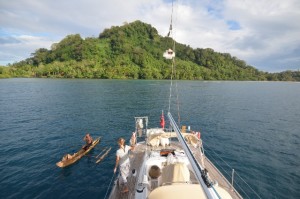
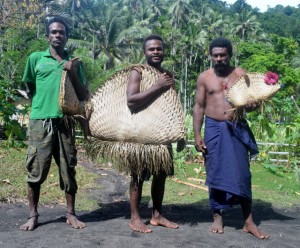
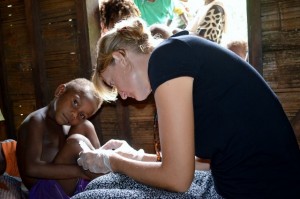
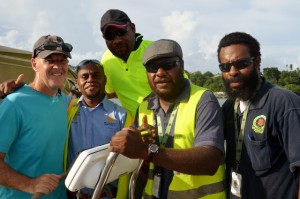
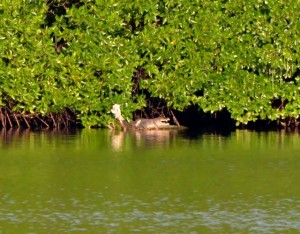
Well done making a safe passage up the five islands. It seems surreal sitting in the mountains, surrounded by snow and reading of your fresh sashimi, man bags and local crocodile. Your descriptions bring back warm memories of our time in PNG three years ago. Fair winds and safe travels. S